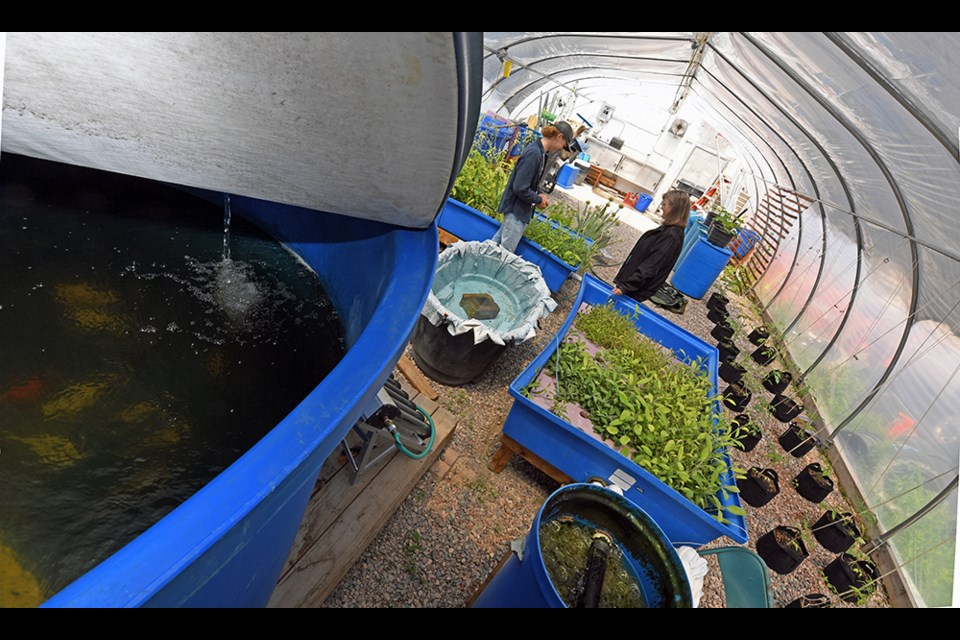A program that emphasizes water based sustainable agriculture is coming into its second decade at Lake Superior State University. What started as a testbed for economical Atlantic salmon micro farming has branched into something that taps the skills of computer engineers to geneticists, all circling around the notion of backstopping the country’s food supply.
The goal that launched the LSSU aquaculture lab in 2012 was to design a mini farm that could grow salmon not on the scale of huge operations based on sea inlets and fjords, but in 1,000-gallon tubs on any landlocked farm that also grew other kinds of livestock – raising fish as a side gig.
A pilot system revolved around developing a large closed-loop tank where the only thing a farmer needed to add - aside from water and solar-generated electricity - was food for fish he raised from fry to fingerling and then sold as a commodity to larger operations.
“Our students won the Judges Choice award from the Michigan Clean Energy Venture Challenge in 2014,” recalled Barbara Evans, LSSU biology professor and from the outset lead advisor for aquiculture and aquaponic projects at LSSU. “We rolled the prize money from that into building a hoop house (a type of outdoor greenhouse) with tanks to grow fish.”
After prototyping systems and winning recognition, the initiative ran into the costly economics of running such an operation, said Evans. So instead of growing fish - aquaculture - the testbed now supports broader research into aquaponics, the applied science of growing consumable plants and vegetables in water that sustains fish as well.
It’s not that fish have been forgotten. More than a dozen koi fish form the foundation of what feeds plants. Waste given off by fish runs through bacteria beds that convert ammonia into the nitrate fertilizer to feed plants in water-only beds.
After the water is wrung of nutrients, it circulates into a tank where it is cooled or heated before returning to the 1,000-gallon fish tank, where the cycle begins again.
“What we are also doing now is called decoupled aquaponics. We use the fish waste as fertilizer for water beds as well as for plants in soil,” said Evens. “Right now, fertilizer costs are going through the roof. Fish waste is a more efficient, sustainable system.”
The yield from soil and water is substantial. Last summer saw 30 pounds of soil-based cherry tomatoes. Water-based beds of squash, carrots, collard greens, sage, green onions, and parsnips saw similar output.
But the endeavor goes beyond yield into imagination.
“Any aspect of aquaponics requires you to learn about ecosystems of plants and fish,” said Evans. “Getting people interested in this is going to promote food security for the country. It gives them some idea of what goes into maintaining a food supply, outside of going to the grocery store. This gets students to tinker and become aware. It’s a maker’s space.”
Engineering students help with the passive solar systems that keep water habitable for fish in winter. They also work with programmable logic controllers - PLCs - to run valves and monitor water quality, even call someone when something is wrong.
The effort is almost exclusively run by the LSSU Aquaculture Club, comprised of students mainly from the sciences. They were responsible for setting up closed-loop plant and fish tanks in the Crawford Hall of Science. The club also resurrected the hoop house last summer, which had been dormant since the pandemic.
It was outgoing club president Cameron Mansell who broadened the hoop house’s focus to include studies where fish exclusively provide food for tomato plants. Another club member, Bobbi Jo Caskey, applied advanced genetic sequencing to take a census of microbes that make fertilizer from fish waste.
“Microbes are the key, but nobody knows what species of bacteria are doing the job,” said Evans. “She sampled the water from our systems and did inhouse identification of all the bacteria.”
It turns out there are thousands of species and subspecies. Caskey’s senior project mapped how this mix of bacteria changes with different plants and fish.
What accounts for such a variety?
“They come in with fish, some are airborne, perhaps even from students,” Evans speculated. “Next-generation genetic sequencing should pick up on unique species of bacteria in soil that convert ammonia into nitrates.”
Evans, Mansell, and current club president Paxton Spencer invite everyone to follow the club on Facebook. They welcome public inquires and hope to get still more LSSU students involved. Look for “Superior AquaSystems LLC”.



